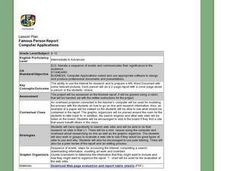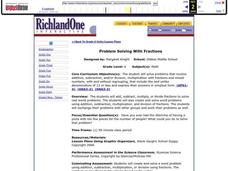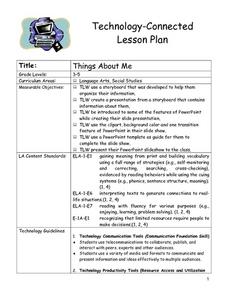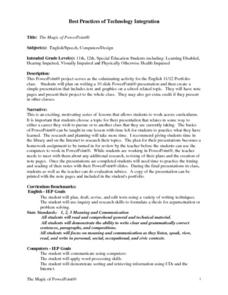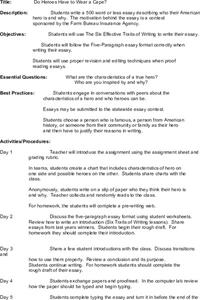Curated OER
Refining Your Public Speaking Skills
High schoolers use the rubric created in the Explore Lesson to help them craft an effective oral presentation worthy of a formal governmental hearing. They polish their oral presentations that are based on their position papers through...
Curated OER
Teach Your Friends Polynomials
Pupils investigate polynomials. In this ninth or tenth grade mathetmatics lesson, students teach their peers the steps to adding, subtracting, multiplying, dividing, and factoring polynomials. Pupils create a PowerPoint presentation...
Curated OER
Narrative Prompt - Lesson 2
Second graders review the structure of a narrative piece of writing. Individually, they write a narrative based on their best day of school. After being read different stories, they share their own narratives with the class. They are...
Curated OER
Famous Person Report - Computer Applications
Students choose famous person to research online, use at least two different sources to find information, prepare rough drafts and document sources, meet in groups for peer feedback, review with teacher, and turn in final report.
Curated OER
Famous People of the Gold Rush
Fourth graders research a famous person from the Gold Rush era. Using the Internet, they take notes from creditable websites and write their rough drafts of their paper. They use peer editing to check for spelling and grammar errors. ...
Curated OER
Cod Calamity
Pupils research the history and aims of sustainable cod fishing in Canada. They read articles, conduct online research, complete worksheets and present their findings to the class. They also complete self and peer evaluations using a...
Curated OER
Problem Solving With Fractions
Sixth graders solve and analyze fractions. In this algebra lesson, 6th graders solve fractions using addition, subtraction, multiplication and division. They work in groups and do peer-review.
Curated OER
The Rain Cycle
Third graders draw the rain cycle. In this rain cycle lesson the students listen to the story The Legend of the Bluebonnet by Tommie DePola. As they listen to the story they sketch what is happening. The students write a sentence for...
Curated OER
Creature Design
Fifth graders create mathematical creatures. In this geometry lesson, 5th graders create a creature from regular and irregular geometric shapes. Students review vocabulary and construct an original creature based on a rubric.
Curated OER
Reading to Elementary Children
Students participate in a cross-age reading program. In this language arts lesson, students choose a class of younger children and read them the book The Legend of the Bluebonnet. Students reflect upon their service project in a journal.
Curated OER
From Mud to Masterpiece: Individual Clay Mosaic Relief Murals Inspired by Rudy Autio's Public Murals
Students create clay mosaic relief murals as analysis of Abstract Expressionism. In this clay art lesson, students analyze the abstract expressionist art of Rudy Autio and create their own clay mural using fire clay and glazes. Students...
Curated OER
Storytelling
Eighth graders retell stories to peers and the entire class. In this storytelling lesson, 8th graders research short stories and select a short story to retell. Students rewrite the stories in their own words and tell it aloud.
Curated OER
What Can Scatterplots Tell Us?
Eighth graders use data from surveys conducted with parents, peers and themselves to create computer-generated scatterplots. They make inferences from their scatterplots.
Curated OER
Extemporaneous Speeches
Learners analyze current events and write and deliver extemporaneous speeches to the class. They define and discuss extemporaneous speeches, conduct research and deliver their speech, and participate in a peer evaluation of students'...
Curated OER
Revising Your Mystery Story
Students edit and improve their short stories by examining character description, dialogue, and plot elements. In peer editing groups they correct gramatical and spelling errors. they read aloud their new story drafts.
Curated OER
Watermelon Crawl
Learners review "slap leather." They practice each of the individual steps they will need to perform the Watermelon Crawl. Students perform the Watermelon Crawl on their own and perform a peer or self assessment of the performance.
Curated OER
Things About Me
Students watch as the teacher explains how to use a storyboard to plan a PowerPoint presentation. They examine how to use clip art, background colors, and at least one transition before creating a PowerPoint presentation according to the...
Curated OER
Proofreading: Lesson 9
Eighth graders participate in writing a descriptive paragraph with a main idea and supporting details. They generate correct mechanics and spelling while writing this paragraph. When finished, they complete a rubric (that is included...
Curated OER
Powerpoint Portfolio
Students create a ten slide Powerpoint presentation as the culminating project for their Language Arts class. Slides include information based on a school related topic or question. Powerpoint presentations are peer reviewed by the class.
Curated OER
The Editing Process
Students in upper-level college-bound English classes review the editing process and terms such as, tone, diction, transition, and conclusion. They read and evaluate a sample essay and identify parts they feel they could improve on. ...
EngageNY
Speaking and Listening Skills: Practice
After reviewing their resources from the unit, scholars participate in multiple group discussions with a World Café activity. During the discussions, they share ideas about their focus questions pertaining to Canada's natural resources...
EngageNY
Revision and Illustration: Strengthening the Writing in my Rainforest Field Journal and Adding a Labeled Drawing
Let me draw you a picture. Scholars read a quote from Roger Tory Peterson and discuss his views on drawings. They then create their own drawings of an ant or butterfly to add to their science journals.
Science 4 Inquiry
Eukaryotic Cells: The Factories of Life
Eukaryotes include humans, animals, and plants. Scholars learn about the parts of eukaryotic cells. They design models of a store and match the correct function of each part to the function of a part of the cell. They review their...
Curated OER
Do Heroes Have to Wear a Cape?
Young writers choose a person from American history, their community, or their family to use as the subject of a persuasive essay. The process begins with a discussion of the characteristics of a hero, the completion of a prewriting web,...





